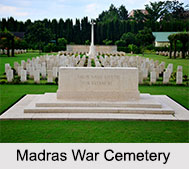 Located on the Mount-Poonamallee Road at Nandambakkam, the Madras War Cemetery is also a memorial which was created to receive the graves from many civil and cantonment cemeteries in the south and east of India where their permanent maintenance could not be assured. It was set up in 1952 by the Commonwealth War Graves Commission (CWGC) and is currently maintained by the CWGC in partnership with the government of India.
Located on the Mount-Poonamallee Road at Nandambakkam, the Madras War Cemetery is also a memorial which was created to receive the graves from many civil and cantonment cemeteries in the south and east of India where their permanent maintenance could not be assured. It was set up in 1952 by the Commonwealth War Graves Commission (CWGC) and is currently maintained by the CWGC in partnership with the government of India.
Architecture of the Madras War Cemetery
The cemetery has the names of more than 1,000 soldiers who died during the First World War. Each of the graves within the cemetery has the names of the people along with the year or the period when they served the nation. The place has gardens that are maintained regularly through ensuring cleanliness of the place. On the entrance to the cemetery the people are welcomed with a Stone of Remembrance where they are greeted with the words from the Book of Ecclesiastes: `Their Name Liveth Forevermore`. Another architectural characteristic of the cemetery is the Cross of Sacrifice which is set up on an octagonal base bearing a bronze sword upon its shaft. The memorial situated at the rear end of cemetery is designed in the form of a Lawn Cemetery. It contains names of the British soldiers who lost their lives during the war along with martyrs from many different nationalities like UK, Canada, New Zealand, Australia, West Africa and India.
The place is one of the most visited places in Chennai and is known to be a major tourist attraction for the people around here and all over the world. The presence of graves of soldiers and civilians from different nations further makes it an attraction for both the local as well as international tourist. The rich historical heritage associated with the place also makes it eligible to be a popular tourist spot. Every year on the 11th of November, during the Armistice Day, important dignitaries and socialites gather in the war cemetery and offer prayers in the memory of those deceased soldiers who lost their lives during battle.
Visiting Information on Madras War Cemetery
The Madras War Cemetery is located at a mere distance of about 5 km from the Chennai International Airport and is only 1km away from another popular spot called the St. Thomas Mount. The nearest railway station is the Chennai Central Railway station at a distance of 17km from the war cemetery.



















